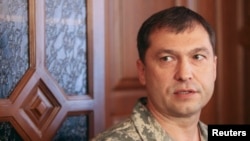Since the Ukrainian government reestablished control over the eastern city of Slovyansk on July 5, the self-proclaimed Luhansk People's Republic has been on the defensive.
Ukrainian forces have been pushing to isolate the city of Luhansk and to cut the insurgents off from access to the border with Russia. But the going has been slow, the authorities say, because of increased supplies of weapons and volunteers coming across the frontier.
In the middle of June, Ukrainian government forces entered the city of Shchastya and established control over part of the border with Russia. On July 14, the army took control over Metalist, Oleksandrivsk, and other towns in the vicinity of Luhansk.
At present, the separatists control only the southern part of Luhansk Oblast, including the city of Luhansk.
It is a far cry from the heady days of April, when militants seized the local headquarters of the state security service. Three weeks later, on April 28, the loosely organized fighters proclaimed the Luhansk People's Republic (LNR), and on the next day they seized other government buildings in the city.
Two weeks after that, on May 11, 96 percent of locals -- according to results released by the separatists -- voted in a disputed referendum to support LNR's independence.
'Military Junta'
Although the LNR is usually lumped together with the other breakaway region in eastern Ukraine, the self-proclaimed Donetsk People's Republic (DNR), and the two have signed an agreement forming the Novorossia confederation, they are quite different, analysts say.
The leadership of the LNR is "more centralized," says local political analyst Oleksiy Blyuminov. Although there are factions as there are in the DNR, the LNR has a dominant president in Valery Bolotov. Blyuminov says the governing structure there is "a military junta in the best sense of the word."
Yuliy Fedorovskiy, another local political observer in Luhansk, tells RFE/RL's Russian Service that LNR is a "military democracy." He notes that Bolotov and his inner circle are all veterans of the Union of Paratroopers of Luhansk Oblast. They are more "leftist" than their comrades in Donetsk, and Bolotov's statements often have a distinctly Soviet feel.
In June, Bolotov formed a State Security Committee (KGB), with a counterespionage arm called SMERSH, after the Stalin-era antispying program.
Bolotov's power is balanced to some extent by a group surrounding Aleksey Mozgovoi, a local commander who is formally subordinate to Bolotov in the political hierarchy and simultaneously to Novorossia military commander Igor Girkin, aka Strelkov, militarily and operationally. He opposed Bolotov at a demonstration on April 21 at which gathered protesters "elected" the LNR leadership.
Fedorovskiy also notes that the Cossacks from Russia's Don River region have considerable influence in the LNR. The group of Don Cossacks is headed by Russian Nikolai Kozitsyn. Fedorovskiy says Kozitsyn controls the stretch of the Russian-Ukrainian border that remains in militant hands and "does not want to recognize Bolotov as the sole leader."
'Less Russian Influence'
Blyuminov says that, apart from the Cossacks, Russian citizens have less influence in the LNR than in the DNR and have managed to secure fewer high-level official posts. However, Russian political strategist Marat Bashirov was named LNR acting prime minister earlier this month. He is a well-known Russian spin doctor with ties to Putin-connected oligarch Viktor Vekselberg.
LNR Deputy Prime Minster for finances Dmitry Semyonov is also a Russian, as are about 10 senior people in the so-called power ministries (defense, interior, emergency situations, etc.).
By all accounts, local Ukrainians control the so-called Luhansk Army of the Southeast. Ukrainian military expert Oleksiy Orestovych estimates the force consists of several thousand fighters, of whom some 30-40 percent are Russian volunteers or mercenaries. Blyuminov, on the other hand, puts the total force at 12,000-15,000, of whom about 10-15 percent are Russians.
Bolotov's political dominance of the region means that there is no single military commander of the stature of Strelkov, which often translates into a lack of tactical coordination.
The region's main advantage -- or lifeline -- is its physical connection with Russia. Military analyst Orestovych estimates that the number of separatist fighters in the area has increased, rather than decreased, since the Ukrainian government began its offensive there. He believes the government's "antiterrorism operation" has been less effective than Kyiv claims.
"The situation is not improving," he says. "[The government] does not have sufficient forces or power."
The intensified fighting has made the situation inside the city of Luhansk more tense for local residents.
"It is dangerous to walk around the city," says a young man who identified himself only as Ihor. "Not only for activists, but for ordinary people as well During the curfew, men found out on the streets are often forced to go into the Army of the Southeast."
Another local named Petro told RFE/RL that he has heard of at least 30 people who have been abducted by militants.
Ihor used to run a local art center and exhibition space. He says that during one event, militants came and said it was a curfew violation.
"They started shooting into the paintings," Ihor says. "But some of the girls spoke with them, gave them a drink, and they settled down."
Shortly afterward, Ihor closed the space because most of his colleagues and clients had fled Luhansk.

